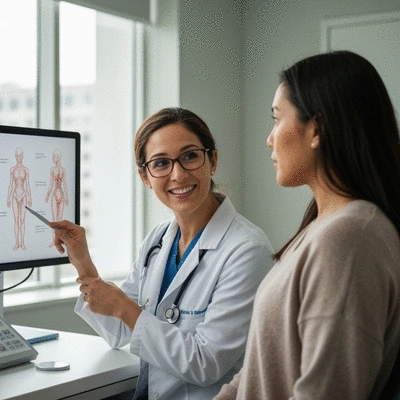1 Modified Radical Mastectomy (MRM)
- Removes entire breast tissue
- Includes axillary lymph node dissection
- Preserves chest muscle

In the journey of understanding breast cancer treatment options, knowledge is a powerful ally. Grasping the nuances of surgical procedures like modified radical mastectomy can significantly impact your decision-making and sense of control.
Delve into the distinctions between various mastectomy types, highlighting the specific features and benefits of Modified Radical Mastectomy (MRM) in comparison to other procedures.
A modified radical mastectomy (MRM) is a surgical procedure primarily used to treat breast cancer. It involves the removal of the entire breast as well as some of the axillary (underarm) lymph nodes. This approach balances effective cancer treatment with the preservation of underlying muscle tissue, allowing for better recovery and cosmetic outcomes. At Mastectomy Insight Hub, we understand how overwhelming it can be to navigate these medical terms, so let’s break it down together!
In essence, MRM is designed to address the specific needs of breast cancer patients while minimizing physical changes. Many women find that understanding what this entails helps to ease their concerns. Have you or someone you know considered this option? Sharing experiences can be incredibly supportive!

Modified radical mastectomy is a surgical technique that entails the complete removal of breast tissue and the lymph nodes in the axilla—an area that can harbor cancer cells. This method is particularly significant when cancer is diagnosed at a stage where removal of the entire breast is necessary, yet it allows for greater cosmetic preservation compared to a traditional radical mastectomy.
These features not only target cancer but also aim to enhance recovery and quality of life, demonstrating the importance of personalized treatment plans. Are you curious about how this might apply to specific situations? Let's explore that further!
Understanding how MRM differs from other mastectomy types can illuminate your choices. Each type serves specific purposes based on the individual's diagnosis and treatment goals. It’s essential to know these distinctions when discussing options with your healthcare provider.
A simple mastectomy involves the removal of the entire breast without lymph node dissection. This is often recommended when the cancer is confined to the breast tissue alone. In contrast, MRM includes lymph node evaluation, which is crucial for staging cancer and planning further treatment. The American Cancer Society provides detailed information on various mastectomy types, helping patients distinguish between options like simple mastectomy and MRM. Understanding these differences can empower you as you engage in conversations about your options.
A radical mastectomy entails the removal of the breast, chest muscles, and lymph nodes, which can lead to more significant changes in body aesthetics and recovery time. MRM, however, focuses on removing breast tissue and lymph nodes while preserving as much muscle as possible. Many patients prefer MRM for its less invasive nature and overall impact on recovery. For a deeper dive into the historical context and evolution of mastectomy techniques, you can refer to studies on the development of modified radical mastectomy.
Nipple-sparing mastectomy allows for the removal of breast tissue while preserving the nipple and areola. This option may be available for select patients depending on tumor location and size. The decision to pursue this route relies heavily on individual circumstances, and it’s often discussed in conjunction with MRM.
Genetic testing plays a pivotal role in determining the best surgical approach for breast cancer patients. Knowing whether you carry specific genes, like BRCA1 or BRCA2, can guide decisions regarding MRM. These tests can indicate a higher risk for cancer recurrence, influencing both surgical choices and preventative strategies. For comprehensive information on the genetic basis of breast cancer and how it influences treatment, the National Center for Biotechnology Information offers extensive resources on BRCA1 and BRCA2 genes.
By understanding your genetic predisposition, you can engage more effectively with your healthcare team, ensuring that you choose the most appropriate and effective treatment plan for your individual journey. What are your thoughts on the impact of genetics in these discussions?
Did you know? Engaging in open conversations with your healthcare team can significantly enhance your understanding of the modified radical mastectomy process. Prepare a list of questions before your appointments to ensure that you address all your concerns and feel confident about your surgical journey.
A Modified Radical Mastectomy (MRM) is a surgical procedure for breast cancer that involves removing the entire breast and some of the axillary (underarm) lymph nodes, while preserving the chest muscles. This approach aims to effectively treat cancer while allowing for better cosmetic outcomes and recovery compared to more extensive surgeries.
A Simple Mastectomy involves the removal of the entire breast but does not include the dissection of lymph nodes. MRM, however, includes the removal of axillary lymph nodes in addition to the breast tissue, which is crucial for staging cancer and determining further treatment.
A Radical Mastectomy is a more extensive procedure that removes the entire breast, chest muscles, and axillary lymph nodes. MRM is less invasive as it preserves the chest muscles, leading to better body aesthetics and a shorter recovery period.
Genetic testing, particularly for genes like BRCA1 and BRCA2, can identify a higher risk for breast cancer recurrence. Knowing your genetic predisposition helps guide decisions regarding MRM, influencing surgical choices and preventative strategies to create a personalized treatment plan.

Open communication with your healthcare team is essential for understanding your treatment options, discussing concerns, and tailoring the treatment plan to your specific needs. Preparing questions in advance and being honest about your fears can foster a collaborative environment that prioritizes your health and well-being.
As we conclude our discussion on Modified Radical Mastectomy (MRM), it’s essential to reflect on the key takeaways that empower patients and their families. Understanding the intricacies of the procedure, recovery expectations, and the importance of informed decision-making can significantly impact your journey. Each step is crucial, and being well-informed can help ease the anxiety surrounding surgery.
Informed decisions are not just about choosing the right surgical option; they’re about understanding the implications for your health and well-being. I encourage you to engage with the information provided, ask questions, and seek clarity on any aspect that may be uncertain. Remember, you are not alone in this journey; many have walked this path and are here to share their experiences.
Making informed decisions surrounding your treatment options is vital. Here are a few factors to consider:
These considerations can equip you with the knowledge needed to advocate for your health. I always emphasize the importance of patient education; it’s about empowering you to make choices that resonate with your needs and values.
Open communication with your healthcare provider is essential. Being able to discuss your concerns and preferences creates a partnership in your care. Here are some tips for fostering that dialogue:
Remember, your healthcare team is there to support you. By sharing your thoughts and asking questions, you create a collaborative environment that prioritizes your health.
As you navigate your journey after considering MRM, connecting with support networks can provide invaluable assistance. Resources such as support groups, online forums, and local organizations can offer both emotional and practical support. Here’s how to get started:
Engaging with others who have faced similar challenges can foster a sense of community and provide comfort as you move forward in your healing journey.
Community resources play a vital role in your recovery and beyond. These resources can include:
These opportunities not only help you in your recovery but also provide avenues to learn and grow, ensuring a holistic approach to your well-being.
Finally, I encourage you to take proactive steps in prioritizing your health and well-being. This journey is not just about surgery; it’s about embracing a new chapter in your life. Reflect on what health means to you and take actionable steps toward achieving it. Whether it’s joining a support group, seeking therapy, or engaging in wellness activities, your health is worth the investment!
Let’s remember, knowledge is power, and with the right resources and support, you can navigate your journey confidently. At Mastectomy Insight Hub, we’re here to provide you with information, resources, and a community to help you thrive. Together, let’s take these next steps toward a healthier, empowered future!
Here is a quick recap of the important points discussed in the article:
Managing Pain After Mastectomy

Have you ever wondered how to navigate the complex journey of recovery after a mastectomy? The path
Preparing Physically for Mastectomy

As you prepare for a mastectomy, consider how your physical readiness can dramatically influence you
Understanding Modified Radical Mastectomy

In the journey of understanding breast cancer treatment options, knowledge is a powerful ally. Grasp
Managing Pain After Mastectomy
Preparing Physically for Mastectomy
Understanding Modified Radical Mastectomy
Lessons from Mastectomy Recovery Stories
Mental Prep for Mastectomy Surgery